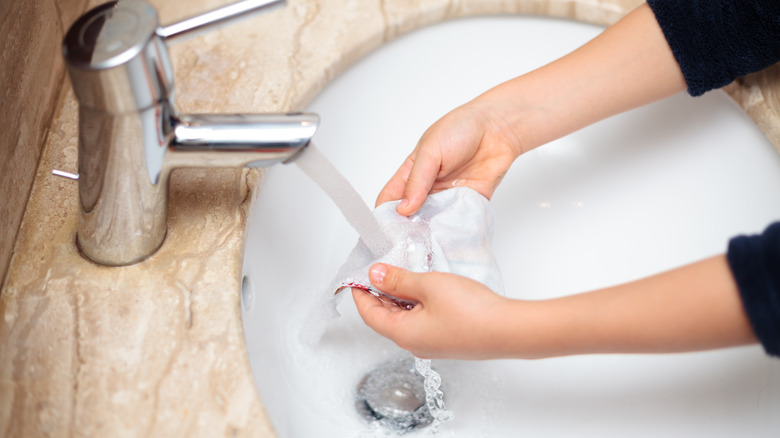The One Household Product You Should Have On Hand For Menstruation Stains
Of all common laundry stains, blood is one of the most difficult substances to remove. Of course, if you happen to be a person with a menstrual cycle (or a parent to one), you're already well-acquainted with this. While menstrual blood isn't necessarily any more difficult to remove than other blood, the delicate and absorbent nature of the fabric typically involved in laundering menstrual stains poses a unique challenge. Fortunately, there is a simple handy household staple that can fight blood stains, even on the most delicate fabrics: hydrogen peroxide.
Yes, the same brown bottle you may reach for to clean and disinfect the surfaces in your home can also be a lifesaver when it comes to removing blood stains. If you've been struggling with cleaning menstrual stains and the most expensive specialty detergents don't seem to fix the problem, it may be time to give humble hydrogen peroxide a chance.
How to treat menstrual stains with hydrogen peroxide
To avoid a permanent stain, do not rinse your bloodied garment in warm water. Instead, rinse away as much blood as possible with 100% cold water. This method should be used regardless of how you plan to wash the item. For best results, start the cold rinsing process while the blood is still fresh and wet. Before you commit to removing the stain with hydrogen peroxide, test a small area of the garment by applying a mixture of half peroxide and half water to ensure that the fabric doesn't get discolored. This can occur on dark or extremely delicate items, which may not be suitable for washing with peroxide.
If the test area is a success, apply the same mixture to the blood stain. When the hydrogen peroxide comes into contact with the blood, it should begin to foam. Try to contain the foam within the stained area of the garment. When you notice the foam starting to subside, dab it away with a paper or cloth towel and apply more of the peroxide mixture. Repeat this process until the stain either disappears or becomes only slightly visible, then wash with detergent and cold water. If you're attempting to treat dried blood, scrape away any solid deposits and then follow the above steps using undiluted hydrogen peroxide. Just note that this method increases the chances of discoloration.
How hydrogen peroxide removes menstrual blood
Thanks to blood's unique composition of proteins and enzymes, plus its tendency to coagulate and bind to fabric fibers, regular detergent alone is often not enough to remove it — especially if the stained garment isn't washed immediately. Coagulation can be triggered by warm temperatures, so washing blood-stained clothing or bedding in warm water with detergent and then drying it in a hot dryer can lead to a permanently set stain.
Combining cold water and hydrogen peroxide can remove blood stains by preventing coagulation and weakening the bonds between the blood's proteins and fabric fibers. The foaming that occurs when peroxide comes into contact with blood is a chemical reaction that loosens these bonds and lifts away the menstrual stain, and this reaction is known as oxidation. Give hydrogen peroxide a try next time you're facing a menstrual stain. Not only will you save money and rescue more of your garments, but you'll also gain undeniable cool points for turning your functional laundry room into a beginner's chemistry lab.


